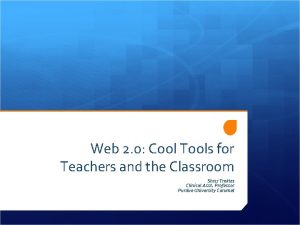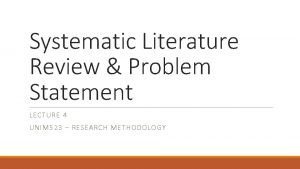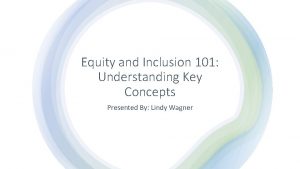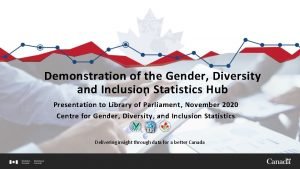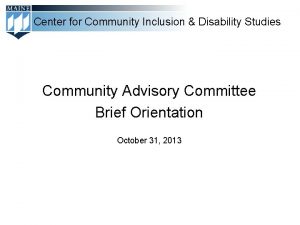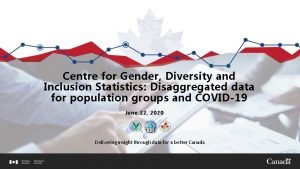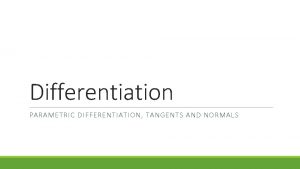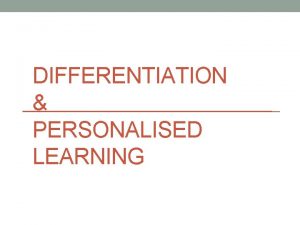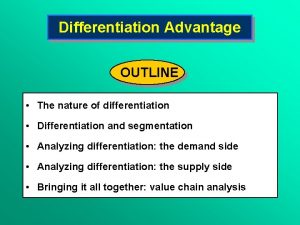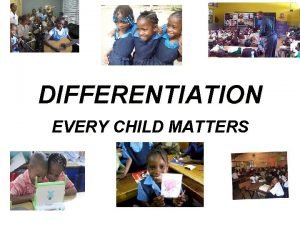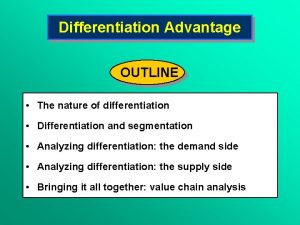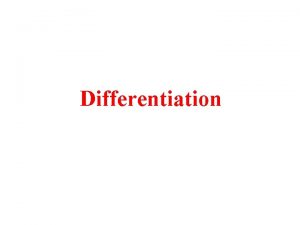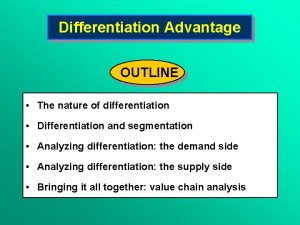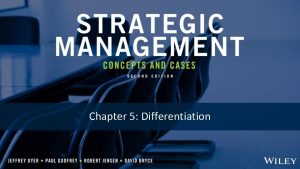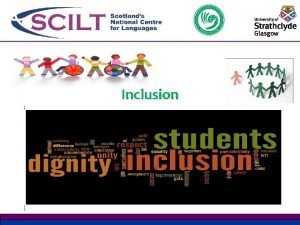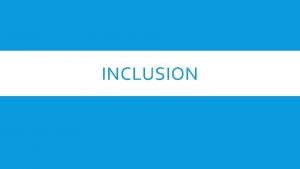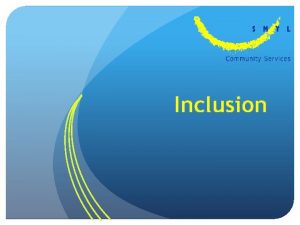Differentiation and Inclusion Tips and Tools for Teachers















- Slides: 15

Differentiation and Inclusion Tips and Tools for Teachers by Patricia Moran

What Is Differentiation? 3 -2 -1 On your paper write: • 3 words to describe what differentiation means to you • 2 barriers or challenges you face with differentiation • 1 goal that you have as a teacher regarding differentiation

The Is/Is Nots of Differentiation Source: Tomlinson (2001) Is Is NOT multiple approaches to content, process, and product giving advanced students more work and struggling students less work giving choices one size fits all curriculum and lessons student centered a chaotic free-for-all a blend of whole class, group, and individual instruction purely individualized instruction flexible grouping homogenous groupings by ability only

What About Inclusion? Inclusion and differentiation should go handin-hand. In a truly differentiated classroom, the teacher is providing learning opportunities for all students, regardless of special education status or ability.

What the research says. . . • • • Traditional instruction models tend to involve teacher delivered instruction with modeling and student practice, followed by a review of the student work through grades or written feedback. Traditional methods tend to be uniform and consistent, and involve subjects and skills that change little. This type of instruction tends to adequately meet the needs of about half the students in the room (De Jesus, 2012). In one study, after implementing a four part differentiated instruction plan in a middle school math class, 67% of the students showed improvement from fall to winter testing, and 67% of the class was on target for mathematical standards (Patterson, Connolly & Ritter, 2009). William Glassner's Choice Theory (1988) explains the benefits of extrinsic and intrinsic motivation, and how providing choices can aid in fostering students to assume responsibility for their own motivation and learning

Where to Begin? There are three ways to differentiate: 1. content 2. process 3. product If you are just beginning-choose one!

Differentiating Content Adapt what you teach OR how you give students access to what you teach Examples: Provide materials for a variety of levels and interests (books, manipulatives, text, handouts, etc) use mini-lessons to provide instruction that focuses on various levels of thinking and provides opportunities to expand or reteach concepts Learning contracts Varied support systems such as graphic organizers, audio recordings/videos, peer mentors and tutoring Identify Key ideas, concepts, and vocabulary. Use these as the starting point or "bare bones" of your instruction. • • •

Learning Contracts A written agreement between teacher and student outlining the skills they will learn and/or practice and how they will do so. A presentation on learning contracts: Source: O'Reilly Learning Design

Differentiating Process How you deliver your instruction, as well as how the students experience the learning process. Examples: • • using scaffolded instruction presenting big ideas or information using multiple avenues (cooperative learning, direct instruction, videos/audios, graphic organizers, independent • • • study, etc) Giving choices that incorporate student interests and learning styles learning centers Cubing

Cubing An overview of the cubing strategy:

Differentiating Product Offering choices on how students show what they've learned. *this is an easy place to start for beginner differentiators Examples: • • • tic-tac-toe choice boards varied performance tasks learning menus

Choice Boards and Learning Menus

Resources Judith Dodge, Differentiation in Action, Scholastic Teaching Resources • includes ready-made resources such as graphic organizers, menus, choice boards, and practical strategies Carol Ann Tomlinson, How to Differentiate Instruction in Mixed-Ability Classrooms, Pearson Merrill-Prentice Hall • gives overview of differentiation and how to implement it in your classroom Laurie E. Westphal, Differentiating Instruction With Menus (Language Arts and Math) • offers examples and reproducibles for grades K-2 and 35

http: //daretodifferentiate. wikispaces. com/ http: //www. differentiatedinstruction. net/ http: //www. ascd. org/research-atopic/differentiated-instructionresources. aspx http: //www. judydodge. com/jd/Home. html

References De Jesus, O. N. (2012). Differentiated Instruction: Can Differentiated Instruction Provide Success for All Learners? . National Teacher Education Journal, 5(3), 5 -11. Dodge, J. (2005). Differentiation in action. New York, NY: Scholastic Teaching Resources Glassner, W. (1988). Choice theory in the classroom. New York, NY: Harper Collins Patterson, J. L. , Connolly, M. C. , & Ritter, S. A. (2009). Restructuring the Inclusion Classroom to Facilitate Differentiated Instruction. Middle School Journal, 41(1), 46 -52. Tomlinson, C. A. (1995). How to differentiate instruction in mixed-ability classrooms, (2 nd ed. ) Alexandria, VA: Association for Supervision and Curriculum Development.
 Kim kroll
Kim kroll Cool tools for teachers
Cool tools for teachers Literature review problem statement example
Literature review problem statement example Narrative review vs systematic review
Narrative review vs systematic review What is the inclusion and exclusion criteria in research
What is the inclusion and exclusion criteria in research California map to inclusion and belonging
California map to inclusion and belonging Diversity equity and inclusion 101
Diversity equity and inclusion 101 Diversity and inclusion scorecard
Diversity and inclusion scorecard Bhiss
Bhiss Centre for gender diversity and inclusion statistics
Centre for gender diversity and inclusion statistics Center for community inclusion and disability studies
Center for community inclusion and disability studies Diversity and inclusion consulting
Diversity and inclusion consulting Centre for gender diversity and inclusion statistics
Centre for gender diversity and inclusion statistics Etsu equity and inclusion conference
Etsu equity and inclusion conference Korn ferry d&i maturity model
Korn ferry d&i maturity model Diversity training outcomes
Diversity training outcomes

